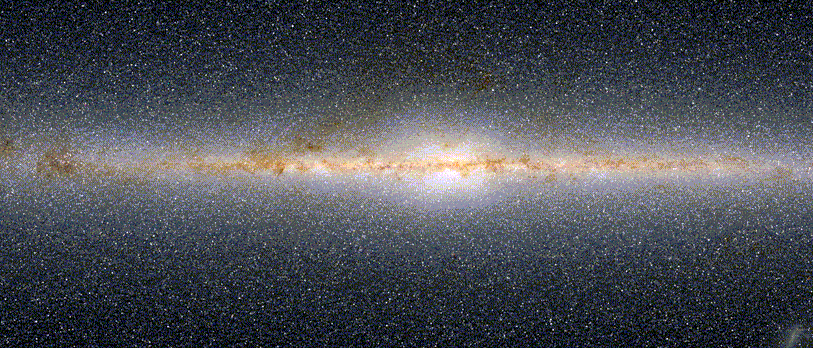 |
|
||||||||||||
| WFCAM Home > Public Information | |||
WFCAM Public InformationWhy do astronomers conduct surveys? What is special about infrared surveys? WFCAM - a widefield infrared camera Scientific projects with WFCAM Why do astronomer conduct surveys?The sky is a big place! The entire Northern and Southern hemispheres cover 41,253 square degrees, and each square degree typically contains hundreds of thousands of galaxies and stars, all of which could be studied in detail by one of the world’s large telescopes. Unfortunately to do so would require more telescope time than will ever possibly be available! So to which ones should we dedicate our precious large telescopes ? This is where surveys come in. The trick of surveys is to study very large areas of sky, spending only a short amount of time at any given position, yet gathering enough information on all the objects that the most interesting ones for further study can be picked out. An imaging survey is the most fundamental kind of survey. In a modern imaging survey, electronic pictures are taken covering large areas of sky. Computer analysis of the images then picks out all the individual objects (stars, galaxies etc.), measures their positions on the sky, their shapes and how bright they are. This is usually repeated through different filters (eg. red, blue) so that the colour of the object can also be calculated. The resulting information on the millions of objects discovered is then usually stored in a database and, these days, made available on-line for anyone to access, eg. http://www-wfau.roe.ac.uk/sss/ The most famous historical surveys were those conducted
using large photographic plates on special wide-angle telescopes
called Schmidt cameras. These plates have now been scanned and
analysed and the data has been available to astronomers for many
years. Among the famous collections are those resulting from:- In recent decades, electronic detectors (of the type used in digital cameras) have taken over from photographic plates and while they are not individually as large as photographic plates, they can be assembled into large arrays and are far more sensitive and accurate. The most famous survey to date with electronic detectors is the Sloan Digital Sky Survey, http://www.sdss.org/ What is special about infrared surveys?The most famous historical imaging surveys of
the sky, such as those of the UK Schmidt telescope in Australia,
were made using photographic plates that were mainly sensitive
to visible light - light which our eyes could see if the objects
were bright enough. However, the great developments in astronomy
in the last hundred years have come from studying electromagnetic
radiation (ie. light) which is not visible. New fields such as
radio astronomy, x-ray astronomy and gamma-ray astronomy have vastly
increased our understanding of the universe. So it is natural that
surveys too should move into using electromagnetic radiation beyond
visible light.
 The detection of faint astronomical radiation in the infrared requires special electronic detectors. These first became available in small sizes around 15 years ago. But development has been rapid and they are now comparable in size to visible electronic detectors. Three types of astronomical objects are particularly well-suited for study in the infrared. Firstly, objects which are very cool such as very low mass stars emit a lot of their light in the infrared. Secondly, objects which lie in or behind large interstellar clouds of gas and dust can have most of their visible light obscured, while the infrared light is much less affected. Thirdly, galaxies at great distances which are moving away from us at high speed due to the expansion of the universe can have much of their light shifted into the infrared. WFCAM – a widefield infrared cameraWFCAM is a new camera for doing surveys in the infrared and was installed on the UK Infrared Telescope on the summit of Mauna Kea in Hawaii in October 2004. See http://outreach.jach.hawaii.edu/ 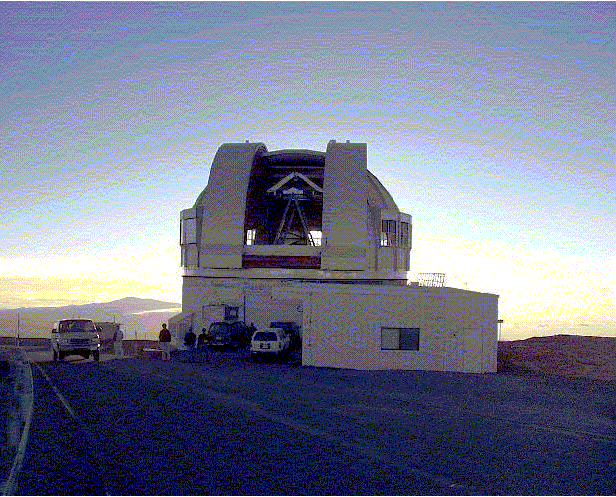 It has a very large field of view using 4 new infrared detectors made by Rockwell Science Center in California. The active area of these is 36mm x 36 mm and one is shown in the picture below. There is a total of 2048 rows and 2048 columns of infrared-light-sensitive pixels. 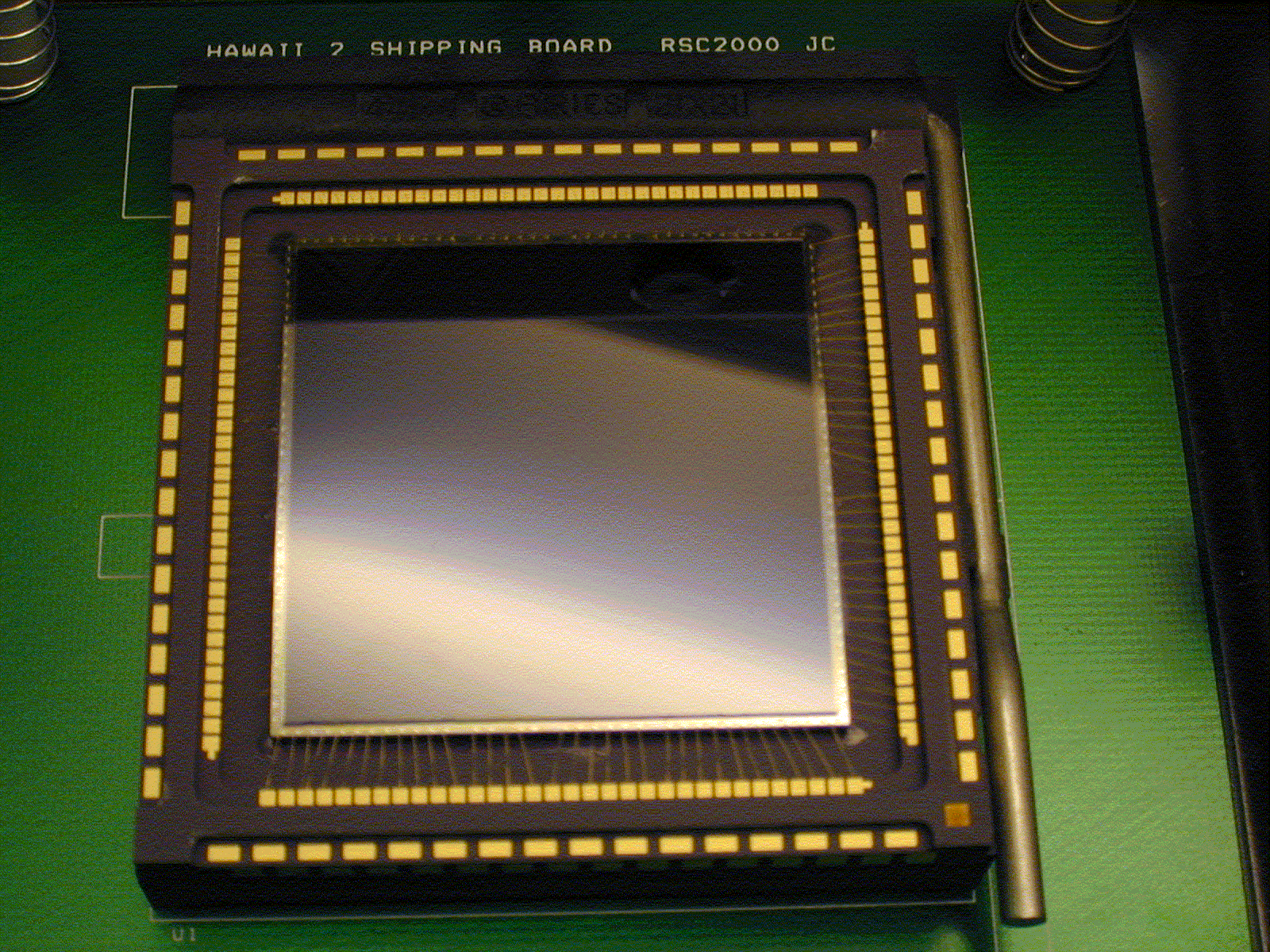 In order to operate correctly, and to be sufficiently sensitive to the faint radiation coming from distant objects in the universe, the detectors must be cooled to -200 C. Of course, at such a low temperature, the detectors would quickly become covered in frost, so the entire assembly has to be constructed inside a large aluminium vacuum vessel (also known as a cryostat) from which most of the air (and water vapour) has been pumped out. Liquid Nitrogen as well as a special Helium refrigerator are required to achieve the low temperatures. The picture below shows the cryostat being cooled down. 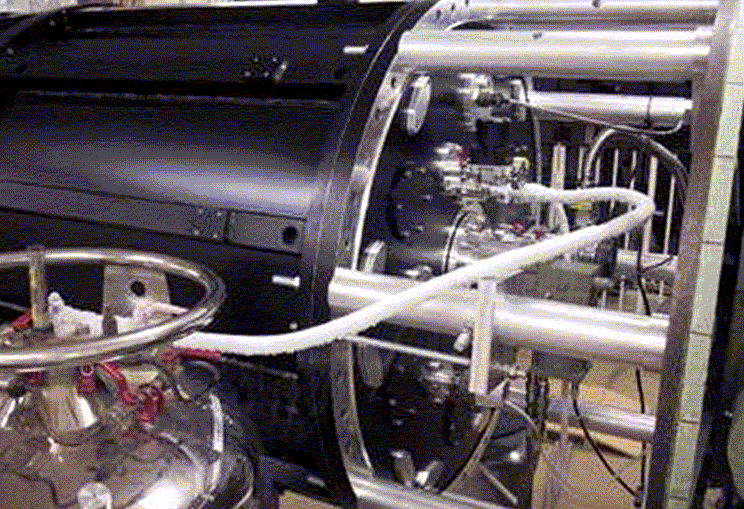 The main cryostat is shown below. It provides the primary mechanical support structure, must have various air-tight fittings which allow electrical signals for the detectors and any internal motors to get in and out, a window to allow infrared light in, as well appropriate joints sealed by plastic o-rings allowing it to be assembled and disassembled. 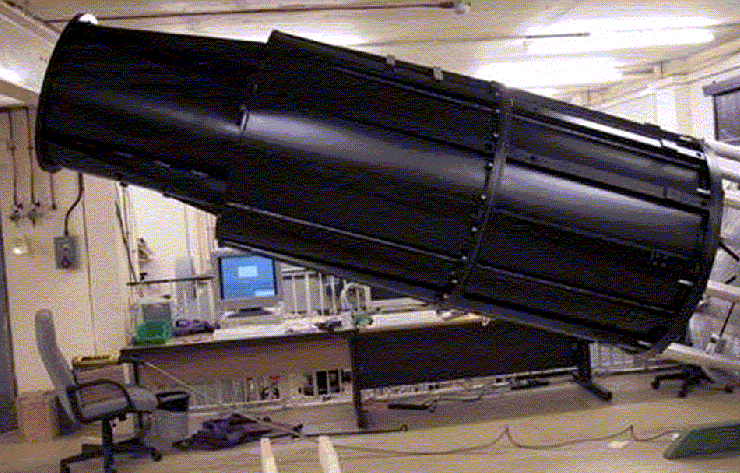
Scientific projects with WFCAMWFCAM is keenly awaited by UK astronomers as
an important new tool in their research. Although it will be available
for individual astronomers or small groups with which to do small
scientific projects, the power of the instrument really lies in
plans to conduct large surveys of the sky, covering thousands of
square degrees. In fact WFCAM could take up as much as 50% of the
time on the UKIRT telescope for many years. The main survey programme
has been designed by a group of astronomers belonging to the UKIDDS
(UK Infrared Deep Sky Survey) consortium. See http://www.ukidss.org/.
Although it was originally intended as primarily a UK survey project,
hence the name, the results will now be distributed to European
astronomers at the same time.
So how is UKIDDS organised ? A common problem that astronomical surveys face is that if an attempt is made at surveying a very large area then only short exposures can be taken at each position, so faint objects will be missed. On the other hand, if a small area is surveyed with long exposures, then rare objects may be missed. A compromise is the “wedding cake” strategy in which multiple surveys are made, each taking roughly the same total time but covering different depths and areas. For UKIDDS there are 5 surveys as shown. 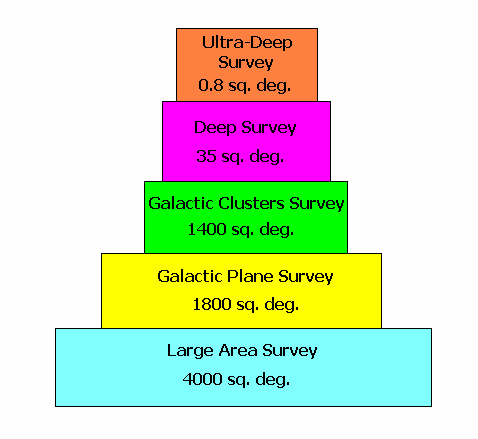 The combination of surveys will be used to tackle
many scientific projects. Among the most important are:-
Brown dwarfs in the solar neighbourhood and in clusters Brown dwarfs are stars which are not massive enough to generate the temperatures and densities in their interiors required for nuclear reactions to take place. This happens for stars lighter than 1/10 the mass of our sun. Such objects therefore do not shine for the billions of years typical of our own sun; they dont have the energy source. Instead they gradually cool and become dark, emitting little light. In fact old brown dwarfs can look a lot like large planets. These cool brown dwarfs emit most of their light in the infrared, so surveys with WFCAM should pick them up in large numbers. 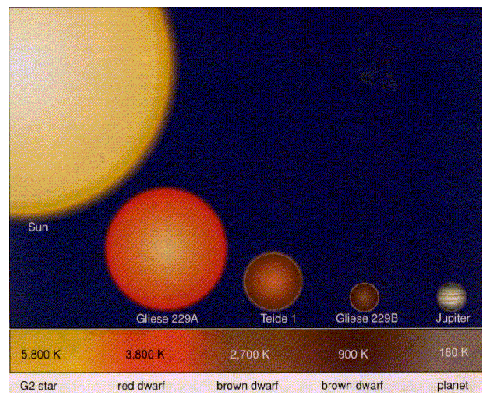 The most distant objects in the universe Quasars can be seen out to enormous distances because they are so bright. Distances on a cosmic scale in astronomy are measured in units of the “redshift”. The most distant quasar known is at redshift 5.8. In the WFCAM survey it is possible we could detect quasars to redshift 7, which would set a new record and enable us to see even further back into the early universe. The structure of our galaxy Our galaxy, the Milky Way, consists of some 100 billion stars, of which our sun is one. One might think we would understand the Milky Way very well since we are inside it, but in fact we are faced by a major problem. Our galaxy like many others has a lot of gas and dust between the stars; these giant clouds obscure our vision of what lies beyond. It is especially difficult to see the far side of the galaxy, so we are not even sure of its precise shape. The infrared WFCAM Galactic Plane survey will clarify the distribution of stars of various types in our galaxy. The following picture comes from the 2MASS (http://pegasus.astro.umass.edu/2mass.html) infrared survey of the milky way and includes light from ½ billion stars!
|
||||
| Last updated on Thursday, 13 January, 2005 2:30 PM |
